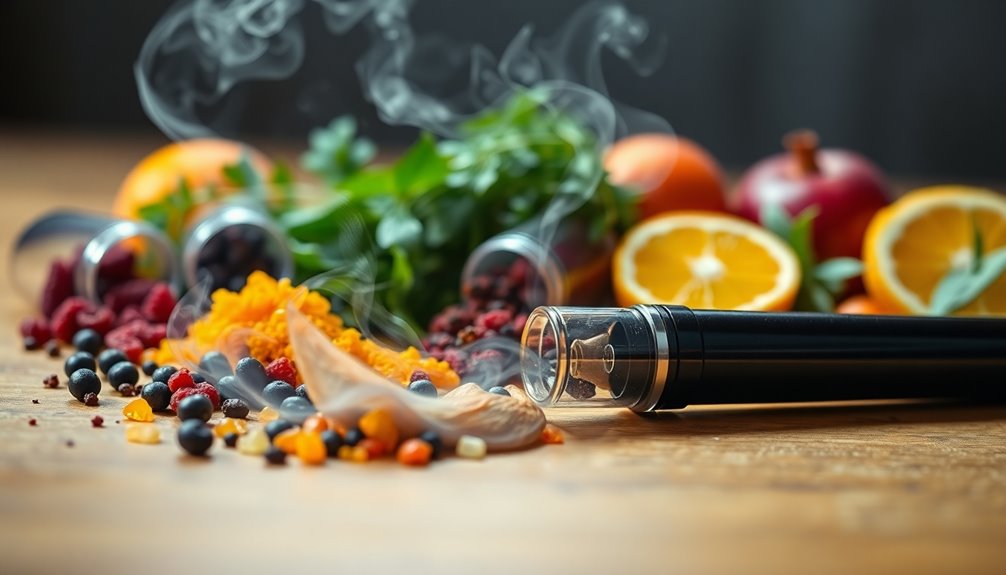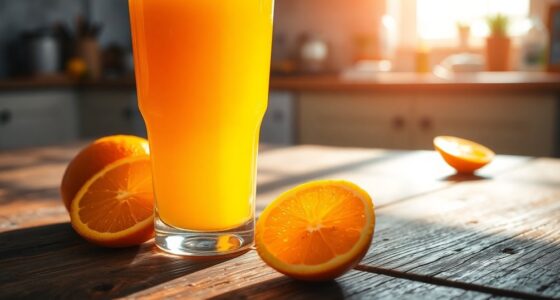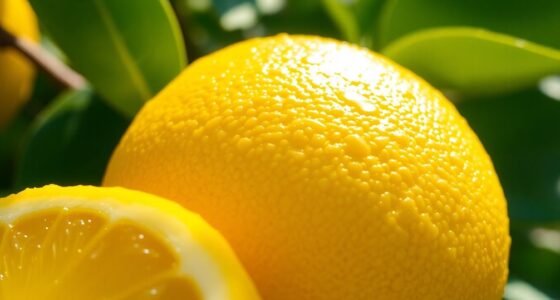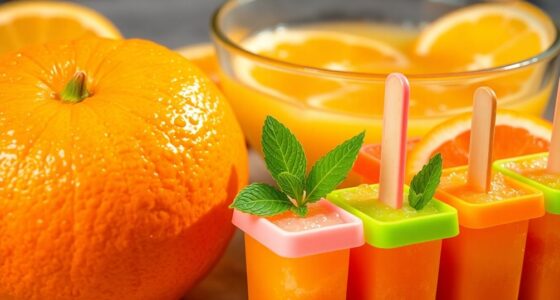To add flavor to your vape juice, start by choosing concentrates from trusted brands, making sure they're safe for vaping. Use about 1-2mls of flavoring per 30ml batch, aiming for 20-30% of the total volume. Shake the mixture well to blend, and let it steep for a few days in a cool, dark place to enhance the flavor. Don't forget to experiment with combinations and adjust ratios according to your taste since there's plenty more to discover!
Key Takeaways
- Choose flavor concentrates from reputable brands specifically designed for e-liquids to ensure safety and quality.
- Use 1-2 mls of flavoring per 30ml batch, aiming for 20-30% of the total volume.
- Shake the mixture vigorously to ensure thorough blending of all ingredients for a cohesive flavor.
- Let the mixture steep in a cool, dark place for several days to enhance flavor development.
- Experiment with different flavor combinations and adjust ratios based on personal taste preferences.
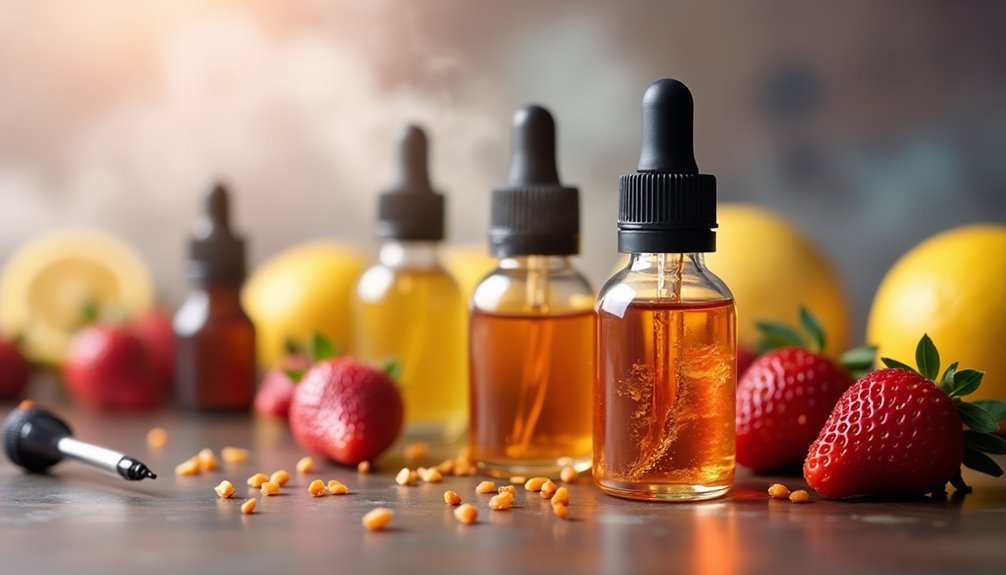
Adding flavor to your vape juice can transform your vaping experience from ordinary to extraordinary. By incorporating vape juice flavours, you can create a personalized blend that suits your taste perfectly. Whether you're a fan of fruity, minty, or dessert flavors, adding the right flavour concentrates can make all the difference. If you're interested in DIY e-liquid, this process isn't only enjoyable but allows you to take control of your vaping experience.
To start, you'll want to choose your flavour concentrates carefully. Look for reputable brands like TPA, Capellas, FA, and LA, as they offer high-quality flavorings specifically designed for e-liquids. Not all food flavorings are safe for vaping, so make sure you're selecting concentrates that are suitable for this purpose.
When it comes to the amount you should use, aim for about 1-2 mls of flavouring per 30ml batch of vape juice. This amount ensures that you’re adding flavor without significantly affecting the nicotine levels in your mix. It’s important to remember that the quality of the flavoring you choose can also influence the overall taste of your vape juice. High-quality flavorings may enhance the complexity of your blend without needing to increase the amount used. Additionally, consider the average price of vape juice in your area, as this can help you balance cost while creating a satisfying and flavorful experience.
Mixing flavours is an art, and your personal preference plays a huge role in the process. A good rule of thumb is to aim for a total of 20-30% of your e-liquid volume being made up of flavour concentrates. You can adjust this ratio based on what you find most appealing, so don't hesitate to experiment. You might find that a little more or less can create the perfect balance for your palate.
Once you've added your concentrates, it's crucial to shake the bottle vigorously. This step ensures that all ingredients blend thoroughly, allowing the flavours to merge and create a cohesive vape juice.
After shaking, you might want to consider the process of steeping. Steeping involves letting your mixture sit for several days, particularly for creamy or dessert flavours. This maturation process enhances the flavour profile and allows the different tastes to develop fully. You'll be amazed at how much a little time can improve the overall experience.
During steeping, keep your e-liquid in a cool, dark place, and give it a gentle shake every few days. This helps to further combine the flavours as they meld together over time. After the steeping period, you can taste your creation and see if it aligns with your expectations. If you feel it needs a bit more of a certain flavour, you can always add a few drops of your concentrate and shake it again.
Ultimately, adding flavor to your vape juice is all about personal preference. Don't be afraid to try new flavours, experiment with different combinations, and adjust your ratios until you find the perfect blend that keeps you coming back for more. With a little bit of creativity and patience, you'll elevate your vaping experience to new heights!
Frequently Asked Questions
How Do I Add Flavour to My Vape Juice?
To add flavor to your vape juice, start by choosing a high-quality concentrated flavoring from a trusted brand.
You'll typically want to mix about 1-2 mls per 30ml of e-liquid.
After combining, shake the mixture well to ensure everything's blended.
If you want a richer taste, let it steep for a few days.
Remember to store your juice in a cool, dark place to keep those flavors fresh and vibrant!
What Can I Add to Vape Juice to Make It Taste Better?
To make your vape juice taste better, you can add concentrated flavorings from trusted brands.
Experiment with different flavors like fruits or desserts, but start with small amounts—about 1-2 mls per 30ml of juice.
You might also consider adding sweeteners to enhance the taste, just be careful not to overdo it.
Steeping your juice after mixing can help the flavors blend and mature, creating a richer vaping experience.
Enjoy the experimentation!
How Can I Make My Vape More Flavorful?
Imagine your vape juice as a bland, unseasoned chicken breast—edible, but oh-so-boring!
To spice things up, you can add 1-2 mls of super concentrated flavoring. Mix different flavors, like a mad scientist concocting a delicious potion.
Use sweeteners carefully, or your coils might start resembling a sticky candy factory.
Store your creation in a cool, dark place, letting the flavors mingle and mature.
Your vape will thank you for the makeover!
Can You Flavor Vape Juice?
Yes, you can definitely flavor vape juice! By adding concentrated flavoring, you enhance the taste without messing with the nicotine content too much.
Just use safe brands like TPA or Capellas, and remember to mix about 1-2 mls per 30ml of e-liquid.
If you're feeling adventurous, try combining different flavors for something unique.
Just keep in mind that some steeping time is needed for the flavors to develop fully. Enjoy experimenting!
Conclusion
In a nutshell, enhancing your vape juice with flavor can take your experience to the next level. Whether you're mixing your own or tweaking store-bought options, a little creativity goes a long way. Remember, it's all about finding what tickles your taste buds, so don't be afraid to experiment! With the right flavors, you'll be hitting the sweet spot in no time, making your vaping sessions truly unforgettable. Happy mixing!
Cindy thoroughly researches juicing trends, techniques, and recipes to provide readers with practical advice and inspiration. Her writing style is accessible, engaging, and designed to make complex concepts easy to understand. Cindy’s dedication to promoting the advantages of juicing shines through her work, empowering readers to make positive changes in their lives through the simple act of juicing.

